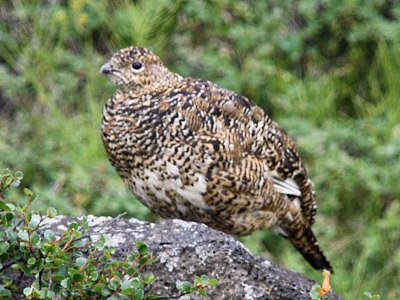|
TRANSLATIONS
"Among the central Esquimaux of North America the contest between representatives of summer and winter, which in Europe has long degenerated into a mere dramatic performance, is still kept up as a magical ceremony of which the avowed intention is to influence the weather. In autumn, when storms announce the approach of the dismal Arctic winter, the Esquimaux divide themselves into two parties called respectively the ptarmigans and the ducks, the ptarmigans comprising all persons born in winter, and the ducks all persons born in summer. A long rope of sealskin is then stretched out, and each party laying hold of one end of it seeks by tugging with might and main to drag the other party over to its side. If the ptarmigans get the worst of it, then summer has won the game and fine weather may be expected to prevail through the winter." (The Golden Bough)
Ptarmigan in summer, Wikipedia. The first thought is that the tug of war between summer and winter should be performed when it can be debated whether winter has come or not (i.e. in autumn). Second thought is that another battle comes half a year later, when winter must be defeated by summer. Points of balance between the two forces could be defined as the equinoxes. But Homer had the war at summer solstice: ... Two were eaten that night for dinner, two the next morning for breakfast, and two the following night. (Six gone.) But the companions meanwhile had prepared a prodigous stake with which to bore out the Cyclops' single eye; and when clever Odysseus, declaring his own name to be Noman, approached and offered the giant a skin of wine, Polyphemus, having drunk his fill, 'lay back', as we read, 'with his great neck bent round, and sleep that conquers all men overcame him.' Wine and fragments of the men's flesh he had just eaten issued forth from his mouth, and he vomited heavy with drink. 'Then', declared Odysseus, I thrust in that stake under the deep ashes, until it should grow hot, and I spake to my companions comfortable words, lest any should hang back from me in fear. But when that bar of olive wood was just about to catch fire in the flame, green though it was, and began to glow terribly, even then I came nigh, and drew it from the coals, and my fellows gathered about me, and some god breathed great courage into us. For their part they seized the bar of olive wood, that was sharpened at the point, and thrust it into his eye, while I from my place aloft turned it about, as when a man bores a ship's beam with a drill while his fellows below spin it with a strap, which they hold at either end, and the auger runs round continually ... The giant lay on his back with neck 'bent round', which means solstice respectively sun's turning around. Of his 12 men 6 had gone. It must be summer solstice. And the giant vomited:
In a tug of war it should begin at a point where both parties stand still. That is when the forces are equal. As soon as one side starts to win it is all over (in mother nature). Therefore it is ridiculous to let the war between summer and winter take place at any other time than a solstice. When the esquimaux did it in autumn it presumably was because they followed the directions from a star, and that star had moved from summer solstice to some point later in the year (due to the precession). Sun moves from east to west, moon delivers the time. She says sun is born at winter solstice. He is the force of summer. Immediately he conquers the dark forces. He is the strong boy in the myths, ready to make battle at once. But it seems that he is the cyclope, the one-eyed giant. In Aa6-65 we can see his eye. He is defeated by smartness, not force. He is defeated by a woman, no-man. It worried me, made me think in the night, that the time order was reversed in H compared with G:
It made me think about the Eskimaux playing on the ice, one party at first winning, and then the other, moving quickly in time. Going downhill you will pass the same landmarks in opposite order. It is a trivial thought when thinking in terms of space. My undisturbed thoughts in the night led me to certain insights. When winter is leaving in spring, the make-up of man can define it to spring equinox:
118 = 472 / 4 = 4 * 29.5 is when winter has left. After another 118 days summer is defeated:
And at 354 (= 3 * 118) next cardinal corner is reached:
From Ga5-7 to Gb5-1 there are 8 * 29.5 = 236 glyphs (days). The year ends at 12 * 29.5 = 354. A rongorongo tablet has only two faces. The creator of G made day 236 come a bit in on side b, thereby making sure that the reader got the continuity from side a. The continuity (or rather discontinuity) from 354 to 355 is no problem, it is evident. Likewise (more or less depending on how much the reader knows) from 118 to 119. In H there are 12 glyph lines on each side. A cardinal corner ought to be found somewhere at the beginning of line a7, because 364 is at *Ha7-20 and number 354 is where the change should be:
Ha7-10 is a great henua, quite in order for marking the end of 4 quarters (rather than of a year). Hipu in Ha7-1 we recognize from Gb4-17:
They are not located at exactly the same point in time, but fairly close:
Ha7-1 is - I think - a good choice of first glyph after moving from line a6 to line a7. |
|||||||||||||||||||||||||||||||||||||||||||||||||||||||||||||||||||||||||||||||||||||||||||||||||||||||||||||||||||||||||||||||||||||||||||||||||||||||||||||||||||||||||||

































